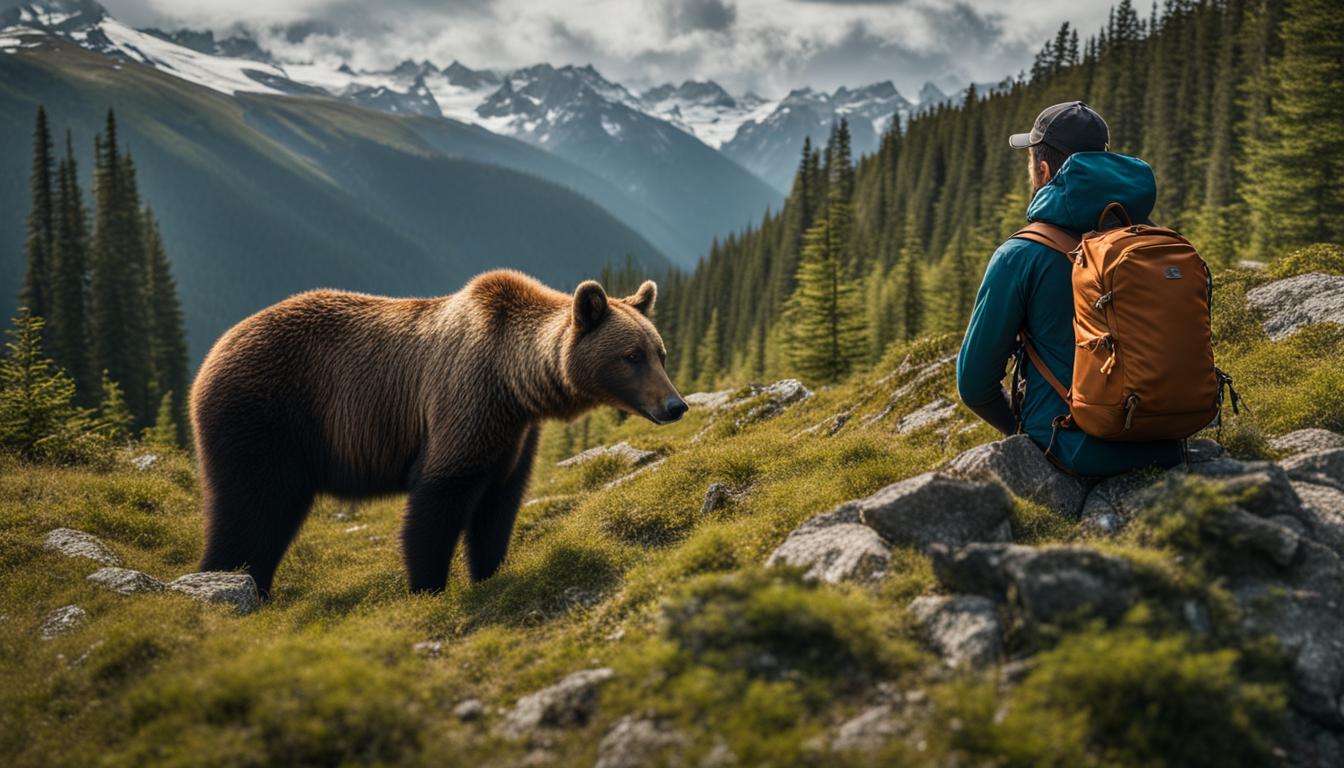When it comes to backpacking in the wilderness, encountering wildlife is an exhilarating part of the adventure. However, it’s crucial to prioritize safety and take necessary precautions to ensure a smooth and secure experience. Whether you’re backpacking through dense forests or traversing through open meadows, being prepared for wildlife encounters is essential.
During my backpacking trips, I’ve learned valuable safety tips to stay safe in the vicinity of wildlife. By following these guidelines, you can enhance your wilderness experience and minimize potential risks. Preserve the beauty of nature and safeguard yourself with these essential precautions:
Key Takeaways:
- Minimize unwanted wildlife encounters by making noise on the trail.
- Avoid hiking at dawn or dusk when animals are most active.
- Properly store food to prevent attracting animals.
- Never feed wild animals.
- Remain calm and slowly back away when encountering cougars or mountain lions.
Tips for Safely Handling Encounters with Specific Types of Wildlife
When venturing into the wilderness, it’s crucial to be aware of how to safely handle encounters with specific types of wildlife. By following these guidelines, you can minimize the risk of harm to both yourself and the animals you encounter.
1. Cougars and Mountain Lions:
“Never approach the animal, make yourself appear bigger, and slowly back away while facing it.”
When encountering cougars or mountain lions, it’s important to remember that they are solitary and elusive creatures. If you encounter one, never attempt to approach the animal or turn your back on it. Instead, stand tall and make yourself appear larger by raising your arms and opening your jacket. Maintain eye contact with the animal while slowly backing away. Do not run, as this may trigger their predatory instincts.
2. Moose:
“Remain calm, talk softly, and move away slowly.”
When encountering a moose, it’s essential to remain calm and avoid sudden movements. Talk softly to alert the moose of your presence and slowly back away, giving the animal a wide berth. Moose can be unpredictable, especially during their mating season or if they feel threatened, so it’s crucial to give them plenty of space and avoid any actions that may agitate them.
3. Bears:
“Never approach them, stay away from mother bears with cubs, be prepared with bear spray, and know how to differentiate between black bears and grizzly bears in terms of appropriate response.”
When it comes to bears, it’s vital to maintain a safe distance and never approach them, especially mother bears with cubs. Be prepared by carrying bear spray and ensure that you know how to use it effectively. It’s also important to know how to differentiate between black bears and grizzly bears, as their behaviors and appropriate responses differ. Educate yourself on the signs of bear activity in the area you are visiting and take appropriate precautions.
4. Snakes:
“Watch for warning signs on the trail, give them space, and know how to react if bitten.”
When hiking in areas where snakes are known to reside, it’s essential to watch for warning signs, such as snake tracks or shed skin, along the trail. If you encounter a snake, give it plenty of space and do not attempt to handle or provoke it. In the unfortunate event of a snake bite, try to remain calm and seek immediate medical attention. Take note of the snake’s appearance to help medical professionals determine the appropriate treatment.
| Wildlife | Handling Guidelines |
|---|---|
| Cougars and Mountain Lions | Never approach them, make yourself appear bigger, and slowly back away while facing them. |
| Moose | Remain calm, talk softly, and move away slowly. |
| Bears | Never approach them, stay away from mother bears with cubs, be prepared with bear spray, and know how to differentiate between black bears and grizzly bears in terms of appropriate response. |
| Snakes | Watch for warning signs on the trail, give them space, and know how to react if bitten. |
Tips for General Wildlife Safety and Preparedness
When it comes to encountering wildlife during backpacking trips, it’s essential to prioritize safety. Here are some essential safety measures and guidelines to ensure a safe and enjoyable wilderness experience:
Educate Yourself and Stay Informed
Before embarking on your backpacking adventure, take the time to educate yourself about the local wildlife. Research their behaviors, habitats, and tracks to better understand their natural tendencies. Staying informed about the wildlife in the area can help you anticipate potential encounters and react appropriately.
Maintain a Safe Distance and Avoid Provoking Wildlife
One of the most important rules when encountering wildlife is to keep a safe distance. Stay at least 50 yards away from animals to minimize the risk of unexpected interactions. Additionally, avoid any actions that may provoke or startle the wildlife, such as running or making sudden loud noises. By respecting their space and behaving calmly, you can reduce the chances of aggressive behavior from animals.
Be Prepared and Practice Responsible Backpacking
Prioritize preparedness by carrying essential safety equipment, such as bear spray, and knowing how to use it effectively. It’s also important to hike with others whenever possible and inform someone of your plans, including your expected route and return time. Carrying emergency communication devices, like a satellite phone or a personal locator beacon, can provide an extra layer of security in case of emergencies. Lastly, practicing Leave No Trace principles ensures that you minimize your impact on the environment and wildlife during your backpacking journey.
By following these essential safety measures and guidelines, you can confidently enjoy the wonders of nature while ensuring your well-being and that of the wildlife you encounter.
How Can Understanding Wildlife Behavior Help in Taking Safety Precautions During Backpacking?
Understanding wildlife behavior is crucial for safer backpacking with wildlife behavior. By recognizing animal signs and knowing how they might react, backpackers can take appropriate safety measures. Avoiding surprise encounters and respecting the animals’ space can prevent dangerous situations. Ultimately, being knowledgeable about wildlife behavior leads to a much safer backpacking experience.
FAQ
What precautions should I take when encountering wildlife during backpacking trips?
Some key tips include minimizing unwanted wildlife encounters by making noise on the trail, avoiding hiking at dawn or dusk when animals are most active, properly storing food to prevent attracting animals, and never feeding wild animals.
How should I react when encountering cougars and mountain lions?
It is recommended to never approach the animal, make yourself appear bigger, and slowly back away while facing it.
What should I do if I encounter a moose?
It’s best to remain calm, talk softly, and move away slowly.
How should I handle encounters with bears?
It’s crucial to never approach them, stay away from mother bears with cubs, be prepared with bear spray, and know how to differentiate between black bears and grizzly bears in terms of appropriate response.
What should I do if I encounter snakes?
It’s important to watch for warning signs on the trail, give them space, and know how to react if bitten.
How should I approach encounters with elk?
It’s essential to keep a safe distance and follow guidelines for encountering them during mating season.
What should I keep in mind for general wildlife safety while backpacking?
It’s crucial to always educate yourself on the local wildlife before your trip, maintaining a safe distance from wildlife, avoiding actions that may provoke or startle them, hiking with others, informing someone of your plans, carrying emergency communication devices, and being well-prepared with necessary protective equipment and practicing Leave No Trace principles.

